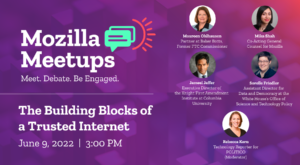I just returned from the 2015 Consumer Electronics Show, and am writing to share a few reflections on the event. I spent most of my time at the “Innovation Policy” CES track, checking out sessions on net neutrality, privacy and the Internet of Things, and patent reform – all topics that will be the subject of many Internet policy headlines through 2015.
Net Neutrality moves forward
Developments at CES made clear that Title II-powered net neutrality, which we have supported on many fronts, is winning. At a high-profile conversation with U.S. Federal Communications Commission Chairman Tom Wheeler, as well as at a session with the other four FCC Commissioners, net neutrality was the primary topic of discussion. Chairman Wheeler went further than in previous speeches in his unequivocal support for Title II and effective net neutrality rules.
Even before Chairman Wheeler’s remarks, at the industry panel I spoke on, Title II was viewed as an inevitable outcome. Until we see the text of rules adopted by 3 or more FCC Commissioners, it’s too soon to declare victory for net neutrality, of course – and even then, there will be challenges to the rules in federal court and in Congress. But the Chairman’s statements clearly indicate that he, like President Obama, has heard the millions of voices raised for real net neutrality.
As the new session of Congress begins, Democratic leaders have already introduced legislation to preserve net neutrality, and all signs indicate that Republican members of Congress are preparing a different legislative solution as well. The FCC is still in the driver’s seat, but if Congress is able to identify a bipartisan legislative solution, that could change – though that is not considered very likely.
Internet of Things is all the rage right now
With the possible exception of net neutrality, the most cited phrase throughout the Innovation Policy track at CES was “Internet of Things” (IoT). (Even the FCC Chairman referenced it in talking about net neutrality, at the risk of triggering a meme-splosion.) On the showroom floor just below the policy discussions, the range of new wearables and Internet-connected technologies on display was staggering.
Reflecting that market’s growth, U.S. Federal Trade Commission Chairwoman Edith Ramirez centered her remarks around concerns over privacy and the Internet of Things. The Chairwoman offered three principles for good corporate practices: security by design, data minimization, and user transparency and choice. These principles are not uncontroversial, and a subsequent panel discussion made clear that much more work needs to be done to figure out how to protect privacy effectively in this emerging area. Mozilla expects to be a significant voice in this effort.
Above and beyond complex privacy concerns, the world of IoT on display at CES reflects not the Internet’s origins of open standards, but instead the silo-driven ecosystems that have prominently emerged alongside mobile devices (see, e.g., coverage at GigaOM). Firefox OS too often seems the lone holdout, extending the greatest open platform ever – the Web – into the world of “things.” For example, at CES Mozilla and Panasonic announced Firefox OS powered 4K TVs. We believe Firefox OS will help maximize the openness of the IoT and the future benefits it can deliver.
On patent reform, more is needed
Last but not least, another major topic in the policy wing of CES was patent reform, with a dedicated session on the issue along with some discussion during a panel of FTC Commissioners. In the 2013-14 Congressional session, Mozilla supported the Innovation Act, a bill designed to help limit abuse of the patent system on several fronts, but that regretfully failed to pass in the U.S. Senate. In 2015, Mozilla, along with other technology companies and public interest organizations, will be working more on this issue.
The panel discussion at CES was heated at times. Some speakers, representing patent holding entities that initiate litigation, contended that recent changes by the regulatory authority, the Patent & Trademark Office, have helped enough. Representatives of small businesses and nonprofit organizations, in contrast, identified the need for many more reforms, including heightened standards for making the initial case of a violation, increased transparency, and fee shifting to discourage unwarranted litigation. Federal courts have taken steps in recent years to limit some abuses of the patent system, particularly in software, though the Supreme Court declined to tackle the question of software patentability head-on in its most recent opportunity, the 2014 decision Alice v. CLS Bank.
It’s great to see policy discussed alongside product at a venue like CES. Policy issues like net neutrality, privacy, and patent reform will make many headlines this year. But they also carry the potential for significant impact on how products are developed and businesses built, how technologies operate and interact with each other, and what sorts of legal and business risks come along for the ride.













